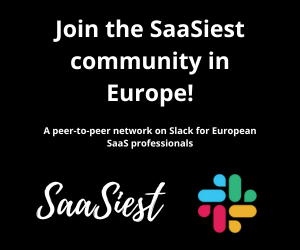Product-led growth (PLG) has become a popular strategy for many B2B SaaS startups. The idea is to get users hooked on your product first through a free or low-cost self-serve offering with the goal of converting them to paying customers later. While PLG can be very effective for customer acquisition, it also comes with challenges that founders need to be aware of.
In his SaaSiest 2023 presentation, Peter Sunna, VP of Product for Kognic, shared insights on PLG based on his experience heading up products for multiple successful SaaS startups.
Takeaways
- Focus on a specific customer segment and build the product just for them. Don’t get distracted trying to please everyone.
- Structure your plans and features to make it clear why customers should upgrade from self-serve to enterprise.
- Invest in both the “hard” product (the actual software) as well as the “soft” product (documentation, services, marketing, sales, etc.).
- Figure out what stage of the adoption lifecycle you are in, and adjust your go-to-market accordingly.
- Balance between bottom-up and top-down strategies based on your strengths. There is no one-size-fits-all approach.
What PLG is
PLG is about a bottom-up approach, targeting the users (not the buyers) who will ultimately use the product. To take this approach, you usually need to deliver value before you capture the value and have self-service capabilities within your product to make it easy for people to use it without you having to invest a lot of time in doing so.
Focus on a key segment
Focusing on a specific segment is key to success. And then holding onto that. It can be tempting to expand to other audiences, but then you dilute your effectiveness. Your core audience can be your Trojan Horse which helps spread your product far and wide. If your users love working with you, they will be your loyal fans and evangelists, championing your product at their current companies and bringing you with them into their next companies.
Build for users who will buy
Contentful had a lot of developers sign up for accounts because it was the newest, latest technology, but they were not prepared to pay for it, meaning we couldn’t convert them into enterprise customers. We coined the term “hipster developers” to describe these users. We had to make sure that even though we knew lots of hipster developers were going to use the product, we couldn’t build the product for them. We wanted to build the product for the professional developers working at enterprise companies who would eventually buy. So we started looking at the acquisition journey in a different way. Instead of just having product-qualified leads, we invented the product-qualified account (PQA) and started targeting and optimizing for that.
Think about the hard product and the soft product
As you try to understand and improve the acquisition journey, it’s easy for a PLG company to get caught up in focusing on how the “hard” product (the software itself) could be changed to improve results. However, that’s not always the answer. Think about the “soft” product as well – that’s everything around the software, including documentation, service, support, marketing, sales, and more. Thinking of those elements as a product can help make conversations and decisions easier while also ensuring you’re considering the full picture.
Differentiate clearly between your self-service and enterprise plans
The self-service, pay-as-you-go offering ended up competing with Contentful’s own sales team, becoming the #1 reason for losing deals. Companies would choose the cheaper self-serve plans over enterprise offerings because the value differentiation wasn’t clear. Startups need to carefully balance features between plans to incentivize upgrading.
Re-evaluate your go-to-market motion at various stages of the adoption lifecycle
Innovators and early adopters are the types of companies and people who are just happy to play around with new technology. They just need the building blocks, which work well with a self-service, PLG motion. Once reaching the early majority at Contentful, customers wanted packaged solutions and more hand-holding, not just self-serve. This required Contentful to re-evaluate and iterate on the acquisition journey, leading the company to develop more traditional sales and account management and expansion capabilities as well. Make sure you also think through the downstream effects, like building a culture and commission model that aligns with your approach.
The hard truth about PLG is balance and playing to your strengths
PLG enables you to acquire and engage users in a scalable way. By making it easy for people to sign up and use your platform – and by building a product customers love – you can grow an army of product enthusiasts who will spread the word and help build a stream of recurring revenue. However, PLG alone is not a silver bullet. To scale successfully, B2B startups need to understand and focus on their specific audience, build capabilities across “hard” and “soft” products, and adapt strategies over time. Finding that balance as you go and looking for opportunities where you have an unfair advantage (playing to your strengths) can propel you to the next level as a product-led organization.
Watch Peter’s presentation on SaaSiest TV to hear more advice and even a few stories along the way, including the battle between Slack and Microsoft and the importance of lemonade in defining product-led growth.




